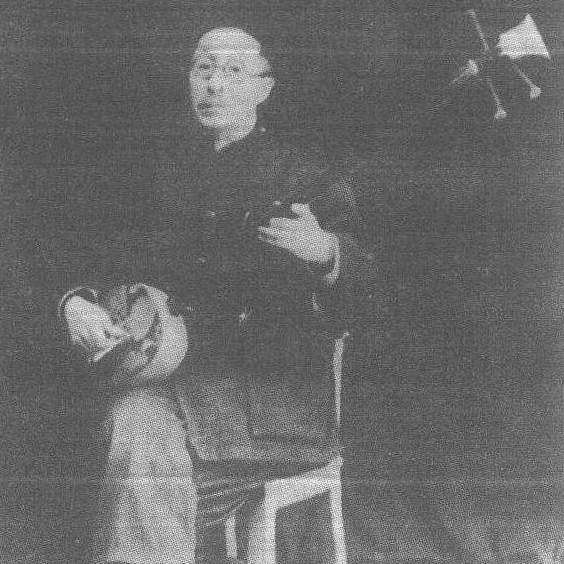Bai Fengyan
Organized by 关谷奇迹 on 2022-04-14

Bai Fengyan (1899-1975), a native of Beijing, was a Chinese quyi string master, composer, sanxian and northern school pipa player. The representative work "Luo Cheng called Guan".
At the age of eight, he studied sanxian with his father Bai Xiaoshan. At the age of 15, he learned arts from Han Yongxian and Han Yonglu. Soon he became famous in the music world. After he became famous, he still sought advice from many famous teachers, such as the famous single-string master Quan Yueru, Deshoushan, and the famous plum blossom drum master Jin Wanchang. Since then, he has become very familiar with many kinds of northern folk art, and has made great efforts to reform and innovate. He is very unique in playing Sanxian, Pipa, Sihu and Yangqin.
He has played for 5 years for Liu Baoquan, a famous drum master in Beijing rhythm. Later, he helped his younger brother Bai Fengming to reform the singing style of the Beijing rhyme drum, and compiled more than 20 new songs such as "Drumming and Cursing Cao", "Seven Star Lanterns" and "Luo Cheng Calling Guan". Since then, the "Shaobai School" of Jingyun drums has been established. In 1954, when he served as the artistic director of the Central Radio Rap Troupe, he even created the "New Plum Blossom Tune".
Similar artist
Wang Yu is a sanxian performer of the China Broadcasting Art Troupe, the vice chairman of the Sanxian Professional Committee of the Chinese Nationalities Orchestra Society, a director of the Chinese Nationalities Orchestra Society, a director of the Chinese Drama Literature Society, and a member of the Chinese Musicians Association.
read >>
Huang Guifang was born on September 22, 1963. He studied music since childhood. In 1977, he was admitted to the Middle School Attached to the Central Conservatory of Music to study Sanxian. In 1982, he was admitted to the Department of Instrumental Music of the China Conservatory of Music for the undergraduate degree and graduated with honors.
read >>
Xiao Jiansheng Male, born in October 1928, from Hunan Province. Professor of China Conservatory of Music. In 1952, he graduated from the Central South Army Art College. Now engaged in the national instrumental sanxian major.
read >>
Xu Fengxia, an internationally renowned Chinese female musician and an important figure in Chinese contemporary classical music, now lives in Germany and graduated from the famous Shanghai Conservatory of Music. She mainly plays four kinds of instruments: Guzheng, Sanxian, Qixian Guqin and Liuqin.
read >>
Tan Longjian, female, born on July 28, 1952, is currently a Sanxian teacher and master tutor at the Central Conservatory of Music.
read >>
Involving musical instruments
The sanxian has three strings in total, hence the name "Sanxian". Chinese traditional plucked instruments were also introduced to Ryukyu, Japan and other places. He plays the main instrument in operas such as Kunqu Opera, Huaihai Opera, Daxianzi Opera, etc.
Involved portfolio
Involved news
Organized by 八日蝉 on 2022-06-15
"One after another, that mountain comes, one after another of water..." The northern Shaanxi folk song "Shandan Dan Blossoms Red and Bright" played by Yan'an Red Street Internet celebrity "Red Street Rabbit" and local folk singer Zhang Yongwang just opened, and it quickly became popular in the audience. There was a "sound wave" in the live broadcast room.
read >>
Organized by 赵锦辛 on 2022-05-07
Put on the drum stand, tune the three strings, the drums start, the three strings move... On the 5th, at the New Era Civilization Practice Station in Tayayi Village, Tayayi Township, Laiyuan County, Hebei Province, Jin You and Wang Shumin, two octogenarians The Xihe drum performance officially opened.
read >>
Organized by 一口泡芙 on 2022-04-11
Changshu is known as "the first book dock in the south of the Yangtze River". Once, there was an old saying in the Pingtan circle: storytellers walking on the dock in Changshu can stay for three consecutive years. This remark not only shows the large number of bookstores in Changshu, but also shows how enthusiastic people in Changshu are to listen to books. There is even a saying that "Pingtan artists do not pass through Changshu Wharf and are not considered to be loud stalls". All of these are enough to explain the prosperity of Changshu Pingtan market and the high level of audience appreciation.
read >>
Organized by 夏浩东 on 2022-04-11
Listening to books is the way of life of Suzhou people. When we talk about listening to books, we mean appreciating Suzhou Pingtan, which is the collective name of Suzhou Pinghua and Suzhou Tanci. Pingtan has a history of more than 200 years since the Qianlong period of the Qing Dynasty, and is known as "the most beautiful voice in China". Geographically, Pingtan does not have Jiaxing in the south, Changzhou in the west, Changshu in the north, and Songjiang in the east.
read >>
Organized by 弥光 on 2022-03-21
The sanxian, also known as the sanxian, is a plucked instrument. There is a special guqin in the old site of the Liuping branch in Wushan of the Communist Party of China. During the Long March, local party organizations used it to send signals to the outside world to cover the safe passage of the Red Army through Wushan.
read >>

 渝公网安备 50010702504639号
渝公网安备 50010702504639号